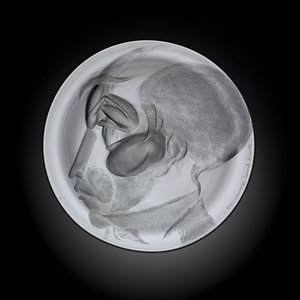 Jiri Harcuba, Portrait of Vàclav Havel (L) and Portrait of VladimÍr Kopecký, 1995. Cast glass, engraved. H 12 in. (tallest) collection: corning museum of glass
Jiri Harcuba, Portrait of Vàclav Havel (L) and Portrait of VladimÍr Kopecký, 1995. Cast glass, engraved. H 12 in. (tallest) collection: corning museum of glass
Though there are 16 Ji?Í Harcuba glass engravings in the collection of the Corning Museum of Glass, the mini-exhibition that opened last month as part of its “Masters of Studio Glass” exhibition series displays a grand total of three. Some insight into the work displayed in the exhibit entitled “Masters of Studio Glass: Ji?Í Harcuba“ on view though October 31st, 2010 comes from a video interview with the artist on the Corning website in which the artist talks about portraiture as a way of expressing “human feelings, emotions, and passions.”
In the process of creating portraits, we learn from his interview, Harcuba learns more about important people from the past. He feels the engraving process is an engagement with his subject, each cut in the glass representing aspects of the personal history of the person he is depicting.
Vladimir Kopecky, Harcuba’s classmate and then fellow teacher at the Academy of Applied Arts, is used as a subject for Harcuba’s Portrait of Vladimir Kopecky (1995) that features very deep cuts through the glass. Harcuba explains that the deep cuts are an attempt to catch Kopecky’s “personality and his way of painting.”
In contrast, his portrait of playwright Vaclav Havel, the first president of the independent Czech Republic after its 1989 Velvet Revolution, employs lighter cuts and the glass retains much of its transparency. Corning curator of modern glass, Tina Oldknow, explained that Harcuba wanted to represent the Japanese Wabi-sabi philosophy that strives for a balance of opposites. In the case of his work, the Portrait of Vaclav Havel and Portrait of Vladimir Kopecky rightly represent that philosophy with the difference of the cutting technique used and the actual people portrayed.
 Jiri Harcuba, Portrait of Dominik Biemann, 2009. Cast glass, engraved. D 9 1/2 in. collection: corning museum of glass.
Jiri Harcuba, Portrait of Dominik Biemann, 2009. Cast glass, engraved. D 9 1/2 in. collection: corning museum of glass.
Oldknow told the Hot Sheet that Harcuba chose the Portrait of Dominik Biemann (2009) to be included as the third work in the show because Biemann was the true inspiration and influence behind his career. Harcuba comments on Biemann’s work saying, “It’s so sophisticated…and at the same time it isn’t over-worked. It has a balance between sophisticated and refined-finish.” Clearly, this balance is what inspired Harcuba himself to create a portrait of Biemann.
In the video interview, Harcuba discusses a wide range of his work and explains exactly what he strives for in his engravings. In his Portrait of Kafka: “it was to express not only him, his face, but the whole time he lived in. It was the twentieth century, this awful time of absurdity.” And the Portrait of Beethoven, expresses “...his solitude, his strong, wish for happiness, which was hidden in the very severe features of his face.”
—Apeksha Vanjari
IF YOU GO:
“Masters of Studio Glass: Ji?Í Harcuba”
Through October 31, 2010
Corning Museum of Glass
One Museum Way
Corning, New York
Website: www.cmog.org


